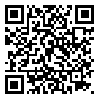Thu, Jul 31, 2025
| فارسی
Volume 30, Issue 1 (Continuously Updated 2024)
IJPCP 2024, 30(1): 0-0 |
Back to browse issues page
Download citation:
BibTeX | RIS | EndNote | Medlars | ProCite | Reference Manager | RefWorks
Send citation to:



BibTeX | RIS | EndNote | Medlars | ProCite | Reference Manager | RefWorks
Send citation to:
Eisazadeh M, Bahramkhani M. Predicting Social Anxiety Based on Attachment Styles, Mentalization Capacity, and Ego Strength in Adolescents of Qazvin City, Iran. IJPCP 2024; 30 (1) : 949.1
URL: http://ijpcp.iums.ac.ir/article-1-4205-en.html
URL: http://ijpcp.iums.ac.ir/article-1-4205-en.html
1- Department of Psychology, Allameh Qazvini Institute, Qazvini, Iran.
2- Department of Psychiatry and Clinical Psychology, Clinical Research Development Unit, 22 Bahman Hospital, Qazvin University of Medical Sciences, Qazvin, Iran. & Social Determinants of Health Research Center, Research Institute for Prevention of Non-Communicable Diseases, Qazvin University of Medical Sciences, Qazvin, Iran. ,m.bahramkhani@gmail.com
2- Department of Psychiatry and Clinical Psychology, Clinical Research Development Unit, 22 Bahman Hospital, Qazvin University of Medical Sciences, Qazvin, Iran. & Social Determinants of Health Research Center, Research Institute for Prevention of Non-Communicable Diseases, Qazvin University of Medical Sciences, Qazvin, Iran. ,
Abstract: (345 Views)
Objectives Several factors are involved in the social anxiety experience of teenagers, and attachment styles and psychological functions, such as ego strength and mentalization, play a significant role. This study predicts social anxiety based on attachment styles, mentalizing capacity, and ego strength in teenage students of Qazvin City, Iran.
Methods This study employed a correlational design. The statistical population of this research consists of teenage students from Qazvin City, Iran, who were selected using a multi-stage stratified sampling method. The number of samples was obtained using the Cochran formula of 380 people, of which 152 girls and 165 boys remained after the drop of subjects. The data was collected using the following questionnaires: Social phobia inventory, attachment style questionnaire, psychological inventory of ego and reflective function questionnaire. Meanwhile, multiple regression was used to analyze the data.
Results According to the results of multiple linear regression, the variables included in the model explained 42.8% of the variance of social anxiety. Ego strength and secure attachment style had a negative and significant relationship with social anxiety. Avoidant insecure attachment style and ambivalent insecure attachment style had a positive and significant relationship with social anxiety. Also, certainty and uncertainty dimensions of mentalization had no significant relationship with social anxiety in the regression model. Although examining the relationship between mentalization and social anxiety using the Pearson coefficient showed a positive and significant relationship between mentalization (certainty) and there was a negative and significant relationship between mentalization (uncertainty) and social anxiety.
Conclusion Attachment styles and ego strength can predict social anxiety in teenagers. Mentalizing capacity alone is related to social anxiety, but in combination with attachment styles and ego strength, it does not have a significant role in predicting social anxiety.
Methods This study employed a correlational design. The statistical population of this research consists of teenage students from Qazvin City, Iran, who were selected using a multi-stage stratified sampling method. The number of samples was obtained using the Cochran formula of 380 people, of which 152 girls and 165 boys remained after the drop of subjects. The data was collected using the following questionnaires: Social phobia inventory, attachment style questionnaire, psychological inventory of ego and reflective function questionnaire. Meanwhile, multiple regression was used to analyze the data.
Results According to the results of multiple linear regression, the variables included in the model explained 42.8% of the variance of social anxiety. Ego strength and secure attachment style had a negative and significant relationship with social anxiety. Avoidant insecure attachment style and ambivalent insecure attachment style had a positive and significant relationship with social anxiety. Also, certainty and uncertainty dimensions of mentalization had no significant relationship with social anxiety in the regression model. Although examining the relationship between mentalization and social anxiety using the Pearson coefficient showed a positive and significant relationship between mentalization (certainty) and there was a negative and significant relationship between mentalization (uncertainty) and social anxiety.
Conclusion Attachment styles and ego strength can predict social anxiety in teenagers. Mentalizing capacity alone is related to social anxiety, but in combination with attachment styles and ego strength, it does not have a significant role in predicting social anxiety.
Article number: 949.1
Type of Study: Original Research |
Subject:
Psychiatry and Psychology
Received: 2024/06/24 | Accepted: 2025/01/1 | Published: 2024/07/31
Received: 2024/06/24 | Accepted: 2025/01/1 | Published: 2024/07/31
| Rights and permissions | |
 |
This work is licensed under a Creative Commons Attribution-NonCommercial 4.0 International License. |






